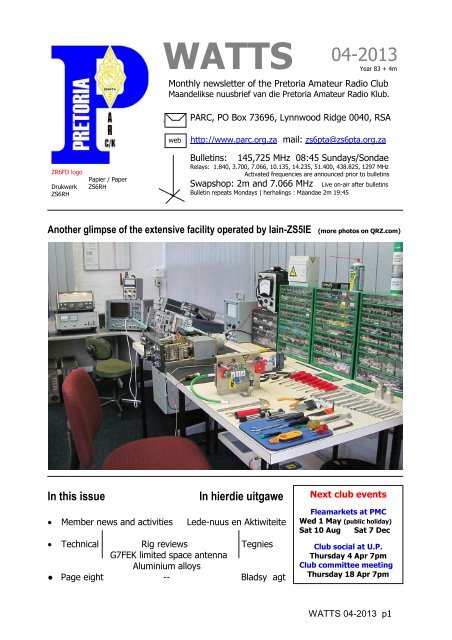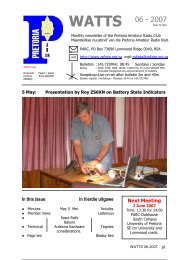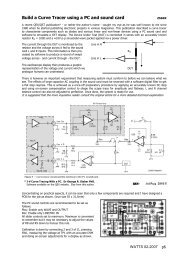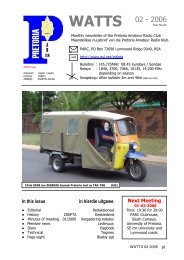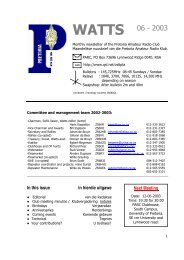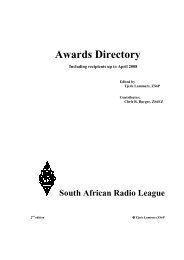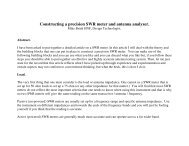You also want an ePaper? Increase the reach of your titles
YUMPU automatically turns print PDFs into web optimized ePapers that Google loves.
WATTS04-2013Year 83 + 4mMonthly newsletter of the <strong>Pretoria</strong> <strong>Amateur</strong> <strong>Radio</strong> <strong>Club</strong>Maandelikse nuusbrief van die <strong>Pretoria</strong> <strong>Amateur</strong> <strong>Radio</strong> Klub.PARC, PO Box 73696, Lynnwood Ridge 0040, RSAwebhttp://www.parc.org.za mail: zs6pta@zs6pta.org.zaZR6FD logoDrukwerkZS6RHPapier / PaperZS6RHBulletins: 145,725 MHz 08:45 Sundays/SondaeRelays: 1.840, 3.700, 7.066, 10.135, 14.235, 51.400, 438.825, 1297 MHzActivated frequencies are announced prior to bulletinsSwapshop: 2m and 7.066 MHz Live on-air after bulletinsBulletin repeats Mondays | herhalings : Maandae 2m 19:45Another glimpse of the extensive facility operated by Iain-ZS5IE(more photos on QRZ.com)In this issueIn hierdie uitgawe Member news and activities Lede-nuus en Aktiwiteite Technical Rig reviews TegniesG7FEK limited space antennaAluminium alloys● Page eight -- Bladsy agtNext club eventsFleamarkets at PMCWed 1 May (public holiday)Sat 10 Aug Sat 7 Dec<strong>Club</strong> social at U.P.Thursday 4 Apr 7pm<strong>Club</strong> committee meetingThursday 18 Apr 7pmWATTS 04-2013 p1
PARC Management team / Bestuurspan Aug. 2012 – Aug. 2013Committee membersChairman, Contests Pierre Holtzhausen ZS6PJH zs6pjh@telkomsa.net 012-655-0726 082-575-5799Vice Chairman, SARL liason Fritz Sutherland ZS6SF fritzs@icon.co.za 012-811-3875 083-304-0028Secretary, <strong>Club</strong>s, Strategy Jean de Villiers ZS6ARA zs6ara@webmail.co.za 012-663-6554 083-627-2506Treasurer, SARS Andre van Tonder ZS6BRC andreh.vtonder@absamail.co.za 361-3292 082-467-0287Rallies, Social Johan de Bruyn ZS6JHB zs6jhb@gmail.com 012-803-7385 079-333-4107Webmaster Graham Reid ZR6GJR greid@wol.co.za 083-701-0511RAE, Bulletin co-ordinator Vincent Harrison ZS6BTY zs6bty@telkomsa.net 012-998-8165 083-754-0115Repeaters, Technical Craig Symington ZS6RH zs6rh@hotmail.co.za 081-334-6817Technical, Kits. PR, youth Rudi van Dyk ZS6RVD vdykr@telkomsa.net 082-962-4141Co-opted/Geko-opteer:Auditor Tony Crowder ZS6CRO tcrowder@telkomsa.net 011-672-3311WATTS newsletter/Kits Hans Kappetijn ZS6KR zs6kr@wbs.co.za 012-333-2612 072-204-3991<strong>Club</strong>house Pieter Fourie ZS6CN pieter2@vodamail.co.za 012-804-7417 083-573-7048Fleamarket Alméro Dupisani ZS6LDP almero.dupisani@up.ac.za 083-938-8955Historian, Archives, Awards Tjerk Lammers ZS6P zs6p@iafrica.com 012-809-0006-† OM Bill Ingleson ZS6KO SKOM Bill passed away in the morning of 15 March after a long illness of severalmonths. He was 85 years and a PARC member for 65 years in 2012 .It is difficult to describe his enormous contribution to the amateur radio hobbyand was the perpetual tinkerer and home-brewer with a great love for Morse Codecommunication for which he built many a QRP rig.He will be missed by many regulars on the CW bands.Bill was always game for field days and fox hunting and set many an example tomotivate others in these persuits. He also was club chairman in 1976,1977 and1993 as well as a committee member at various times.Numerous awards came his way and he will always be remembered for his DesertIsland Awards where some really imaginative stories came forth to amuse theaudience.R.I.P. old friend. We will miss you.IMPORTANT INFORMATION TO ALL LICENCEESICASA now has three people dealing with amateur licensing, divided by section of the alphabet asshown at the end of this item. The details, email addresses and telephone number are:A-B-C-D-E-R-S-TKhutso Mashile011 566 3313011 566 3314Kmashile@icasa.org.zaF-G-H-I-J-K-U-W-X-Y-ZPetunia Mashile011 566 3657011 566 3658PMMashile@icasa.org.zaL-M-N-O-P-Q-VDelmar de Witt011 566 3339011 566 3340DdeWitt@icasa.org.zaLicense fees coming up 1 AprilThe license fee of R120.00 is due on 1 April 2013. You mayalso renew for up to five years at a reduced fee. See below.1 year - R120.002 years - R230.003 years - R329.004 years - R419.005 years - R501.00Always include your call sign as a payment reference.WATTS 04-2013 p2
BirthdaysApr.VerjaarsdaeApr. AnniversariesHerdenkings01 Melanie, daughter of Peggy and Ed ZS6UT 06 Lynn and Andre ZS6BRC04 Joe ZS6AIC 12 Rika and Errol ZR6VDR ( 44 )04 Dino ZS6DNO 30 Joey and Graham ZS6GJR ( 30 )08 Bertha, lv van Hans ZS6KR08 Klasie, seun van Sylvia en Tjerk ZS6P09 Tanya, daughter of Pat ZR6AVC and Frank ZS6GE 18 Eric ZS6ME10 Joey, sw of Graham ZS6GJR 21 Wynand ZS6ARF10 Callan, son of Phil ZS6PHL and Craig ZS6RH 22 Marieta, sw of Roy ZS6MI12 Jan ZS6LJ 25 Gerhard, son of Sander ZS6SSW13 Liam ZR6RAF, son of Heather and Vincent ZS6BTY 28 Tracey, daughter of Rita and victor ZS6VG16 Tobie, seun van Margriet en Tobie 29 Heather, sw of Vincent ZS6BTY30 Robert ZS6PROLief en Leed | Joys and SorrowsWell done PARC participants!Andre ZS6GCA was in hospital for an operationDiary | Dagboek(UTC times)Apr04 SARL 80m QSO Party 17:00-20:0006-07 SP DX Contest 15:00-15:0013-14 JIDX CW Contest 07:00-13:0019-20 Holyland DX Contest 21:00-21:0020-21 YU DX Contest 21:00-17:0027-28 10-10 Int. Digital Contest 00:01-23:5927-28 SP DX RTTY Contest 12:00-12:0027-28 Helvetia Contest 13:00-12:59Snippets | BrokkiesPat Hawker MBEG3VA, SK<strong>Radio</strong> amateurs aroundthe world will besaddened to learn ofthe death of Pat HawkerMBE, G3VA, on 21February 2013.He was 90 years old.Pat was an amazing person, working withclandestine radio supporting WWII resistanceunits, but best known for his work with the RSGBconducting the Technical Topics column inRadcom magazine.That column typically covered a new or interestingtidbit in a few paragraphs, and sometimes adiagram.Others would have milked it out into a long article,but G3VA was able to distill the necessaryinformation and tell the reader just what heneeded to know.Schalk ZS1LL our distant member(Ed: If my memory serves me right, he wotenumerous articles for Practical Wireless as well)WATTS 04-2013 p3
Summary of QST rig reviewsfrom http://www.remeeus.eu/hamradio/pa1hr/productreview.htmWATTS 04-2013 p4
G7FEK Limited Space AntennaG7FEK Multi-band “Nested Marconi” Antenna (rev 5).(Abridged version – Get the full .pdf off the net)This antenna was first conceived as a simple dual band antenna in 1988, in an attempt to achieve sensible dual bandoperation in a small garden of 14m (46 ft) length. Evolving from a simple end-fed Marconi for 80m, the idea was touse the opposing harmonic relationships of two ¼ wave elements so that they could be fed on odd harmonics withoutmutual coupling. This principle has been used with nested dipole antennas and other specialist multi-band antennassuch as the Cobweb, but because of interaction and coupling issues, it’s rarely implemented on end fed wireantennas. With this version of the antenna, interaction between elements and top resonance have been turned to ouradvantage allowing for excellent multi-band working, while maintaining a useful radiation pattern and efficiency onalmost all <strong>Amateur</strong> <strong>Radio</strong> bands.The suggested dimensions provide for low radiation angle (30 to 40 degrees) on all bands except 30m where theantenna acts as a full size horizontal dipole. Low VSWR is achievable on most bands and, with careful construction,up to four bands can be used without ATU. Radiation resistance is in the range 25 to 200 ohms on all bands, ensuringhigh radiation efficiency, even with moderate earthing arrangements. Unlike the Windom or G5RV, the fundamentalbands can be resonated independently.The G7FEK antenna looks a little like a small, off centre, G5RV. If anyone has tried a G5RV in 46ft of garden you willknow that performance is not that great, and the “½ size” G5RV is completely useless on 80 meters.During sunspot minimum, putting out a good signal on 80m can mean the difference between operating HF radio ornot, as most other bands are not in good shape. This antenna allows anyone to achieve an effective full size 80mantenna in a small garden with excellent low angle DX performance, closely matching a full size dipole installed at thesame height.So what is it?The original “Nested Marconi Antenna” was first designed in 1988 and in 2007 the antenna was optimized and testedat sunspot minimum to improve performance and multi-band operation. The difference in feed impedance betweenelements determines which element iscoupled to the feeder and which elementfloats, thus automatic band switching occurswithout the need for traps. For the higherbands this antenna utilises the odd harmonicresonance of these elements which are alsoat low impedance. In each case someradiation is coupled from the driven elementinto the main antenna, producing a usefulradiation pattern and omni- directional lowangle performance. On 30m, the tophorizontal section works as an end fed dipolewith ¼ wave transformer feed, as in theZeppelin antenna, giving a dipole radiationpattern while assuring a low impedancefeed.The dimensions have been carefullyoptimized for best multi band performanceand to maintain a low angle radiation patternon all bands for best DX working, whiletaking up only a small physical space.This design is very easy and cheap to build and unlike many limited space antennas, it works very well on 80 meters,a band that many <strong>Radio</strong> <strong>Amateur</strong>s with restricted space have previously been denied.WATTS 04-2013 p5
Aluminium alloysabridged from Wikipedia, the free encyclopedia – and local input by pine ZS6OBAluminium alloys are alloys in which aluminium (Al) is the predominant metal. The typical alloying elements are copper,magnesium, manganese, silicon and zinc. There are two principal classifications, namely casting alloys and wrought alloys, both ofwhich are further subdivided into the categories heat-treatable and non-heat-treatable. About 85% of aluminium is used for wroughtproducts, for example rolled plate, foils and extrusions. Cast aluminium alloys yield cost effective products due to the low meltingpoint, although they generally have lower tensile strengths than wrought alloys.The most important cast aluminium alloy system is Al-Si, where the high levels of silicon (4.0% to 13%) contribute to give goodcasting characteristics. Aluminium alloys are widely used in engineering structures and components where light weight or corrosionresistance is required.Alloys composed mostly of aluminium have been very important in aerospace manufacturing since the introduction of metal skinnedaircraft. Aluminium-magnesium alloys are both lighter than other aluminium alloys and much less flammable than alloys that containa very high percentage of magnesium.Aluminium alloy surfaces will keep their apparent shine in a dry environment due to the formation of a clear, protective layer ofaluminium oxide. In a wet environment, galvanic corrosion can occur when an aluminium alloy is placed in electrical contact withother metals with more negative corrosion potentials than aluminium.Aluminium alloy compositions are registered with The Aluminum Association. Many organizations publish more specific standards forthe manufacture of aluminium alloy, including the Society of Automotive Engineers standards organization, specifically its aerospacestandards subgroups, and ASTM International.Aluminium alloys with a wide range of properties are used in engineering structures. Alloy systems are classified by a numbersystem (ANSI) or by names indicating their main alloying constituents (DIN and ISO). Selecting the right alloy for a given applicationentails considerations of its tensile strength, density, ductility, formability, workability, weldability, and corrosion resistance, to namea few.Aluminium alloys typically have an elastic modulus of about 70 GPa, which is about one-third of the elastic modulus of most kinds ofsteel and steel alloys. Therefore, for a given load, a component or unit made of an aluminium alloy will experience a greater elasticdeformation than a steel part of the identical size and shape. Though there are aluminium alloys with somewhat-higher tensilestrengths than the commonly used kinds of steel, simply replacing a steel part with an aluminium alloy might lead to problems. Animportant structural limitation of aluminium alloys is their lower fatigue strength compared to steel. In controlled laboratoryconditions, steels display a fatigue limit, which is the stress amplitude below which no failures occur - the metal does not continue toweaken with extended stress cycles. Aluminum alloys do not have this lower fatigue limit and will continue to weaken with continuedstress cycles.Alloy designationsWrought and cast aluminium alloys use different identification systems. Wrought aluminium is identified with a four digit numberwhich identifies the alloying elements. Cast aluminium alloys use a four to five digit number with a decimal point. The digit in thehundreds place indicates the alloying elements, while the digit after the decimal point indicates the form (cast shape or ingot).Temper designationThe temper designation follows the cast or wrought designation number with a dash, a letter, and potentially a one to three digitnumber, e.g. 6061-T6. The definitions for the tempers are:-F As fabricated-H Strain hardened (cold worked) with or without thermal treatment-H1 Strain hardened without thermal treatment-H2 Strain hardened and partially annealed-H3 Strain hardened and stabilized by low temperature heatingSecond digitA second digit denotes the degree of hardness-HX2 = 1/4 hard-HX4 = 1/2 hard-HX6 = 3/4 hard-HX8 = full hard-HX9 = extra hard-O Full soft (annealed)-T Heat treated to produce stable tempers-T1 Cooled from hot working and naturally aged-T2 Cooled from hot working, cold-worked, and naturally aged-T3 Solution heat treated and cold worked-T4 Solution heat treated and naturally aged-T5 Cooled from hot working and artificially aged-T51 Stress relieved by stretching-T510 No further straightening after stretching-T511 Minor straightening after stretching-T52 Stress relieved by thermal treatment-T6 Solution heat treated and artificially aged-T7 Solution heat treated and stabilized-T8 Solution heat treated, cold worked, andartificially aged-T9 Solution heat treated, artificially aged, and coldworked-T10 Cooled from hot working, cold-worked, andartificially aged-W Solution heat treated only.Wrought alloysThe International Alloy Designation System is the most widely accepted naming scheme for wrought alloys. Each alloy is given afour-digit number, where the first digit indicates the major alloying elements.1000 series are essentially pure aluminium with a minimum 99% aluminium content by weight and can be work hardened.WATTS 04-2013 p6
8000 series is a category mainly used for lithium alloys. [citation needed] Named alloys2000 series are alloyed with copper, can be precipitation hardened to strengths comparable to steel. Formerly referred toas duralumin, they were once the most common aerospace alloys, but were susceptible to stress corrosion cracking andare increasingly replaced by 7000 series in new designs.3000 series are alloyed with manganese, and can be work hardened.4000 series are alloyed with silicon. They are also known as silumin.5000 series are alloyed with magnesium.6000 series are alloyed with magnesium and silicon, are easy to machine, and can be precipitation hardened, but not tothe high strengths that 2000 and 7000 can reach.7000 series are alloyed with zinc, and can be precipitation hardened to the highest strengths of any aluminium alloy.Alclad Aluminium sheet formed from high-purity surface layers bonded to high strength aluminium alloy core material Birmabright (aluminium, magnesium) a product of The Birmetals Company, basically equivalent to 5251Duralumin (copper, aluminium)Pandalloy Pratt&Whitney proprietary alloy, supposedly having high strength and superior high temperature performance.MagnaliumMagnox (magnesium, aluminium)Silumin (aluminium, silicon)Titanal (aluminium, zinc, magnesium, copper, zirconium) a product of Austria Metall AG. Commonly used in highperformance sports products, particularly snowboards and skis.Y alloy, Hiduminium, R.R. alloys: pre-war nickel-aluminium alloys, used in aerospace and engine pistons, for their ability toretain strength at elevated temperature.From the above listings there are specific alloys for aerospace and aircraft (typically 7075), marine, cycling and automotive use.<strong>Amateur</strong> radio DIY constructors in the US can source 6063-T832 drawn aluminum or 6061-T8 heavy-wall drawn aluminum—bothhighly resistant to corrosion and stress cracking - as a most reliable alloy. Locally we have less choice.Pine ZS6OB advises as follows:All tubular material - 6063 - T6 (the 6063-T832 used for “booms” overseas are a little lighter and harder)All solid material for antennas - 6082 - T6 (solid 6081 normally used overseas is not any more locally available)Lots of tech info in these websites: http://eng.sut.ac.th/metal/images/stories/pdf/02_Aluminium%20and%20aluminium%20alloy.pdfand http://en.wikipedia.org/wiki/Aluminium_alloyQRV Services offers the following expertise: General equipment and TV repairs Small-scale design and manufacturing Frequency and power calibration Technical writing 3 rd Party scrutiny of projects and documents MFJ 259/69 Analyzer repairs and calibration Valuation of ham estates and their disposaland products:Legal limit 30m and 40m dipole trapsLinear power supply O.V. protection kits30A DC switching supplies30A DC Anderson Power PolesConnectors RF and AudioPlug-in triple sequential industrial timerContact Hans at 012-333-2612 or 072-204-3991WATTS 04-2013 p7
MHzF2 Critical Frequency and 4000 km MUF<strong>Pretoria</strong> - April 2013Long Term HF PropagationPrediction for April 2013Courtesy ZS6BTY(see also our website propagation tab)35282114700 2 4 6 8 10 12 14 16 18 20 22 24foF2MUF EastMUF NorthMUF WestMUF SouthDX OperatingThe graph shows the 4000 km maximumuseable frequency (MUF) to the East, North,West and South from <strong>Pretoria</strong> for the first hopusing the F2 layer.Local OperatingThe F2 critical frequency (foF2) is the maximumfrequency that will reflect when you transmitstraight up. E-layer reflection is not shown.UTCWhat you get told at a fleamarketwith translation.Thanks to http://highfields-arc.co.uk/fun/amrad.htmThis rig puts out a BIG signal - It's 50 kHz wide.This is a really good CW rig - It doesn't work on SSB.This is a really good SSB rig - It doesn't work on CW.This is a really good rig - It doesn't work on CW or SSB.The transmitter is outstanding - It doesn't receive.The receiver is really hot - It doesn't transmit.This rig is really hot - It's stolen.It seems to be a vintage regenerative type - It oscillates.I just re-valved it - Got 'em from questionable used valve stock.I just aligned it - The slugs on the transformers are jammed and broken.I don't know if it works - It doesn't work, probably never has.It doesn't chirp - Because it doesn't transmit.The audio sounds great - The mains hum is faithfully reproduced.I just had it serviced - I sprayed WD-40 over all the wiring.It comes with the original box - Just brush out the cat litter.Better buy it now, cause it won't last - Exactly!Sure, it works at full power - It sucks all it can from the wall outlet.This rig has wide frequency coverage - It drifts up and down by 2 MHz.Frequency stability is great - The VFO doesn't work - you'll have to use crystals.Real popular rig in its day - There were whole HF nets on the repair and maintenance problems.RadCom gave this one a really great review - The language broke new ground for profanity.It might need a bit of tweaking - Marconi himself couldn't fix it, much less align it.It was used in government service - It was stored outdoors on a wooden pallet.The dial drive may need lubricating - The gears are stripped and the setscrew's frozen.I plugged it in to check that it lights up - The light came from the two foot high flames.I'm selling it because I have two of them - The working one I'm keeping.You won't find one at a 'better' price - 'Better' defined as solely from the point of view of the seller.This is a collector's item - The manufacturer just went belly up and won't honour the warranty.It came from an SK sale - If you have any problem take it up with the original owner.It worked last time I used it - If it still worked, I'd still be using it.The only lightning damage was a fuse - The only lightning damage I recognised was a fuse.I have the [missing part] somewhere, I'll send it to you, trust me - You'll never see the [missing part].I'll help you carry it to the car - I'll do anything to unload this pile of ****.It works O.K. on 80 meters - It had some parasitics but I got in and really screwed it up and now I want to unload it.The valves used by this rig are worth the asking price - The rig uses a rare 7360 beam deflection tube for a balancedmodulator, but it's blown and you'll spend at least $80+ to get a new one.This is the rig of my dreams I really wanted one of these as a kid, but now I've got to let it go - As I've gotten older, I'velearned what a pile of **** it is.The signal quality of this rig was easily recognisable in its day - The high distortion and bad audio quickly identified this rig.This rig will bring back the feelings and atmosphere of vintage ham gear - The bypass capacitors to the AC line putenough voltage on the chassis to give you a shock in the lips through the microphone, and it smokes so bad when you turn it onthat you'll probably start coughing and wheezing.I'd keep this baby, but my wife is making me clean everything out of the shack - I finally got around to giving this thingthe proverbial heave-ho.There are a couple of other people interested in it - Someone looked at it and laughed.You'd better buy it now, because I'm leaving soon - A previous customer and his BIG brother are heading back toward thetable and they aren't smiling.WATTS 04-2013 p8


